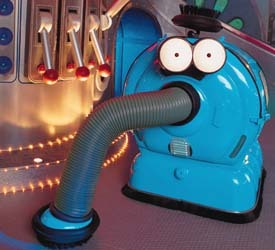eptheca wrote:How are you on MIOS coding? Assembler? C?
My coding level, if you can call it that is copy/paste arduino stuff, so zero 
Well, first and foremost, I would say I'm a 'hardware guy' ( been an EE tech working on radio/communication systems for +25yrs), but the first programming I learned was on an Cosmac 1802 back in the '70s (hand assembly and entered one byte at a time on the front panel. Good times!). I am humbled on a daily basis by the brilliance and creativity that people share on the interWebbies!
So, I am way more comfortable with asm.(but the doc is starting me on new meds); C is all about knowing how to use the pre-built functions and Libs, less about how the processor works, that's a good thing (but hard for a control freak). MIOS is yet another step away from the bare silicon. MIOS handles all the low level IO tasks, so programming an app is a matter of linking the functions in a meaningful way, without having to deal with the details; I.E. reading the SRIO chains, toggling the LCD lines, ect.
And there are allot of very cool MB apps already built, so they only need to be tailored to our own needs, (this can be daunting, I know. You need to understand how the base app works , in order to change it).
The Arduino is really all about this same abstraction from the hardware, that's why it has become so wildly popular. It offers an open door to people with ideas, without forcing them to digest the ATMega Datasheet.
IMO, the MidiBox has evolved into a specialized 'Arduino', focused on handling midi messages and synth HW. Once you get the knack of what the OS and HW does and doesn't allow, the app's logic becomes much easier.
OK, I'll get off the soap box 
eptheca wrote:I would love a CS for the GENMDM with LCD, buttons, LEDs and encoders, but I'm stuck with my limitations.
I also have the space limitations in the ZX case.
Oh yes, I know that feeling! Once you start adding this and that, the beast grows; till you need a suitcase.
eptheca wrote:here's the mock up CS
a bit tight between the pots
I haven't used it enough yet to know which 4 parameters I would like to tweak live, but these are it for now
I'll probably add 2 pots and a button/LED for the DAC parameters on the right side of the case
any suggestions/comments?
Well I'm in the same boat as to what to leave in and what to leave out, but the good news is after the HW's built, you can reconfigure it fairly easy!
The only thing that I can offer, and I am reluctant to question your build, is the use of POTs. With a limited CS, you could handle the less used functions via a remote connection to a DAW or Seq, or use a software menu structure to adjust or load new patch values from EEPROM.
But the problem is: if you want to remotely adjust a variable that a POT controls or reassign the POT to a different function on the fly; you have to deal with the fact that the POT is always reading an absolute analog value that you need to over ride. This leads to sync problems between local and remote copies of the same variable or value jumps when toggling between two variable. POTs are best suited to a 1:1 relationship to a single variable.
Encoders yield relative readings that inc/dec a variable value only when moved, so handling the above issues is far easier. This is why motor faders were used on non-uC controlled mixing consoles and CS' with the introduction of DAW automation. A motor fader's position IS the stored (analog) variable value.
On the HW side, POTs are easier, less complex and simplify the HW, but at a cost of function flexibility. Encoders allow you to reuse that knob for layers of functions, but you end up needing UI feedback; LEDs or an LCD. A POT's position is the user's feedback, done. With encoders you need two inputs per enc.; so your chip count doubles for the same amount of knobs. If you separate the local and remote control functions, using POTs save space, which for your build is a premium.
Hope I don't sound like I'm running you down, just trying to point out design options. You may have already considered all these things, in which case you owe me a "Shut Up!!"
eptheca wrote:
MAN, that is sexy!! Really makes me want to gut a flaky Atari 600XL I have in storage.
eptheca wrote:Noo-noo-fumes, a soldering-man's best friend 

I think you got a product there!! 
Sorry if I bent your ear too much, best of luck!!




